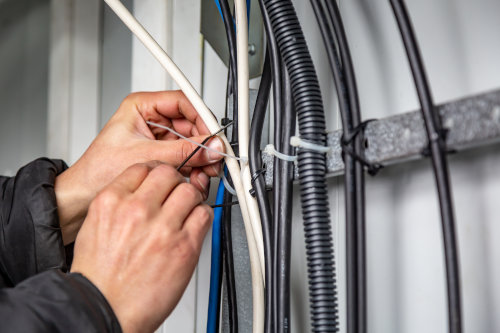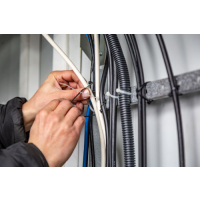- Home
- Blog
- Cable Ties
- 8 Types of Cable Ties: Everything you need to know
8 Types of Cable Ties: Everything you need to know

The humble cable tie is the everyman’s DIY tool. Designed by US company Thomas & Betts back in the fifties, this sturdy invention has proven to be one of the easiest to use and versatile products on the market. Its intended function has not changed over the decades, but its suitability to different purposes has broadened.
Initially devised for aviation purposes, its basic characteristic of holding items together has not faltered. They’re found in the toolkits of professional tradesmen, to the kitchen cupboards of the average homeowner. You just never know when you might need to bundle something together, be it messy wires, a garden shed lock or a tall sunflower.
While cable ties are adaptable, there are a variety of styles available. Knowing which type of cable tie you need for a specific utility is a sure-fire way to getting the best result. Not only this, it can be overwhelming when faced with shelves of cable ties without any expertise.
In this post, we discuss 8 of the main types of cable ties and what they are used for.
Why are there so many types of cable ties?
Cable ties are multifunctional. They are not just for tying cables as the name suggests. While ultimately they serve the purpose of managing and organising wires and cables, their versatility enables them to come in handy for a variety of other applications.
Standard cable ties are most commonly seen in homes and gardens for tasks such as detangling computer wires, child-proofing cupboards and training plants in the backyard. More sturdy types are found on building sites, in auto mechanics, hospitals and in horticultural settings to support the growth of trees.
Today, they are an essential tool in many modern businesses for safety and organisational purposes in the workplace. Using the correct make of cable ties from colour, material and tensile strength is greatly important to industries and DIY enthusiasts alike.
1. Standard cable ties
Standard cable ties are your general, all-rounders and can be found in most homes. The standard type is self-locking and usually crafted for one-time usage. Standard cable ties come in a variety of colours, widths and strengths.
2. Releasable / reusable cable Ties
Releasable cable ties can be used several times, making them the more sustainable choice. Unlike standard cable ties, they can be reopened to add more cables or wires to the bunch.
The ties are more flexible for repeated use, and they don’t need to be cut and destroyed in order to be removed from an item. For this reason, they’re great for recycling around the house. Child-proofing the place can be easily undone when needed, cupboards and doors unlocked, and they work well as a practice run to test the strength.
These ties typically come in white/natural or black nylon.
3. Mounted head cable ties
These cable ties are slightly more complex than standard ties, and have a mounting hole where a single screw is used to firmly fasten down to desired surfaces such as ceilings, desks and walls. They are a fast and efficient way to secure wire bundles to structures.
Mounted head cable ties are usually available on the market in white/natural or black nylon.
4. Push mount cable ties
Push mount cable ties are a secure option for attaching to structures without the need for other fixings like screws. The mounting device is built in and locks into place when manoeuvred into a predrilled hole. Varieties of these ties are available depending on the use.
5. Double headed cabled ties
Double headed cable ties provide double the cable space. The two heads separate parallel cables, and mitigate the necessity for additional cable ties. This multifunctional style works best with heavy duty items and is ideal for separating two cable runs.
6. Stainless steel cable ties
Stainless steel cable ties are chosen for their resistant material, and are most suited to hazardous environments, such as industrial settings where they may encounter high temperatures.
Stainless steel is used for high security cable ties which are resistant to many hazards such as flames, corrosion, UV radiation and extreme weather conditions. This type is far more supportive than nylon and is the best choice for heavy loads.
7. Heavy duty cable ties
As the name suggests, these cable ties are designed to bundle heavier, bulkier cables. The stronger the cables, the more likely they are to force their way out of the ties. Cable ties specially designed for heavy duty will keep them in position and prevent wires from breaking free and causing untidiness, confusion in the workplace and even accidents.
8. Marker cable ties
Marker cable ties are cable ties which have a space for writing on or labelling. The marker type is extremely useful in settings where there are many cables together which need to be separated, for example, in hospital and clinical environments.
Stainless steel marker plates can be used to label pipework and other heavy duty objects.
Wrapping Up
Cable ties are universally used to bind things together. Whatever the item, it’s useful to shop the cable ties market with some general knowledge of which type will do the job best.
Standard options are used regularly by ordinary homeowners and tradesmen alike for general tasks. Elsewhere, resealable or reusable ties are becoming popular as a more sustainable alternative to single-use cable ties.
The above list is not exhaustive, and you are likely to find some other types of cable ties not mentioned in this post. Who knew a seemingly simple creation could progress to such an extensive market? Thomas & Betts certainly broke ground with an indispensable product used worldwide.
In short, everyday cable ties will do the trick for small DIY jobs and for temporary use. But for more specialised scenarios, there are many cable ties out there which will excel at certain tasks.
FAQs
What is the function of cable ties?
Cable ties are fastenings which keep cables and wires gathered together for organisational and safety reasons in the workplace and at home. They are versatile and can be used for many other DIY purposes, and come in various colours, materials and strengths.
What are the different types of cable ties?
There are many types of cable ties to meet different needs, from mounted head, double headed and push mount to standard, heavy duty and stainless steel cable ties. They are available in different lengths, strengths and materials depending on what they are used for.
Which are the strongest cable ties?
Heavy duty cable ties and stainless steel cable ties are the strongest available. These have a high tensile strength and are used in construction, mining industries and in extreme weather conditions.


